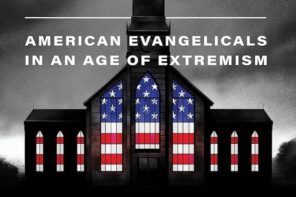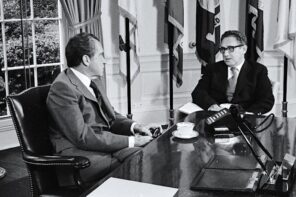The Satanic Temple, the group behind the proposed monument to Satan in Oklahoma, has announced that they will hold a “historical re-enactment” of a black mass at Harvard University today. The event is hosted through the Harvard Extension Cultural Studies Club and will be held in the Queen’s Head Pup beneath Memorial Hall. Only the Satanic Temple knows for certain what will happen. It’s doubtful that true black masses ever occurred and the only recorded incidents of black masses were improvised ceremonies performed by libertines. Still, everyone weighing in on the controversy seems quite certain about how a proper black mass is performed and what it symbolizes.
Lucien Greaves of the Satanic Temple explains that the legend of the black mass was created by church authorities as propaganda, but that Satanists have appropriated it as an expression of personal autonomy and a “symbolic revolt” against arbitrary authority—either religious or secular.
However, some Catholics regard the black mass as a literal conjuring of supernatural evil and a direct attack on Catholicism. Father Roger Landry wrote Harvard president Drew G. Faust beseeching him to halt the event and the Archdiocese of Boston released a statement condemning it. The controversy demonstrates the cycle of appropriation that often occurs between religious authorities longing for a direct encounter with extraordinary evil and dissenters who perform the script of evil.
In an e-mail, Greaves described the black mass as a “non-story,” insisting that it’s meant as a performance of his religious culture and not a deliberate attempt to goad Catholics:
To some, the idea of God is one of a benevolent father; to others, the ultimate tyrant. Catholics may see in the Black Mass an affront against moral decency. Practitioners in the Black Mass should see it as an act of liberation from superstition. Neither should seek to suppress the other’s speech, but to understand what each party is trying to say, even while we may ultimately still disagree.
He added that Catholic detractors “seem terribly disappointed that this event is not all about them, to the point that they refuse to accept it.”
Christians may be rightfully suspicious of the claim that a public performance of a black mass is not meant as a slight against them. But while the politically expedient response would be to simply ignore the Satanic Temple, Catholic and conservative websites have condemned the event, showering it with free publicity. Greaves’ critics demonstrate what Jason Bivins calls “the erotics of fear.” While claiming to be shocked by the black mass, it appears to excite them and potentially confirms their claims about extraordinary evil.
Despite Greaves statement that he doesn’t believe in the supernatural and that the black mass is only a re-enactment, Father Landry stated the black mass is “clearly dealing with conjuring evil.” Elizabeth Scalia of Patheos (no relation to Antonin) asked Greaves, “What he would do if, in the midst of their exercise, something from the etheric plane made itself known.” Greaves laughed and answered, “Well, then I’d have to reassess.”
Scalia also produced a hurried series of blog posts obsessing over whether an actual consecrated host will be desecrated in the black mass. Even when Greaves said a consecrated host would not be used, Scalia appeared determined to keep alive the possibility that an actual host desecration, the sine qua non in legends of the black mass, could occur.
Host desecration stories have a long history going back to the Middle Ages when Jews, rather than Satanists, were accused of infiltrating communion and palming the host to use in obscene rituals. Scalia waspromoting host desecration stories on Patheos years before the Satanic Temple was founded, but the announced black mass offered the tantalizing hope of a documented case that would confirm that they really do occur.
More broadly, a black mass held at Harvard presents fodder for the old anti-intellectual canard that higher education is a bastion of Satan that exists to destroy traditional values under the guise of cultural pluralism, critical inquiry, and free speech. The National Catholic Register called the black mass “a Faustian bargain between Satan worship and academic freedom.” Oklahoma house member Rebecca Hamilton argued that it demonstrated why, “Harvard and its little troupe of elite schools are not healthy for this country.” She suggests that government research grants should be removed from Harvard and given to “non-academic organizations.”
Modern-day Satanists understand that the black mass was a form of propaganda that reinforced a Christian worldview and they have appropriated this legend to symbolize their dissent against Christian hegemony. But the controversy over the Harvard black mass shows that Christian claims-makers can easily re-appropriate the symbols of evil for their own purposes.
In the 1970s, Mike Warnke, a minister who falsely claimed to have been a Satanic high priest, toured the country in a “witchmobile.” This was a mobile “museum” of artifacts allegedly used in witchcraft. The witchmobile allowed Warnke’s audiences to experience a sense of propinquity with extraordinary evil. For Christian claims-makers, The Satanic Temple’s educational re-enactment of a black mass is even more useful than Warnke’s witchmobile: It provides physical evidence of the reality of demonic evil and, in turn, affirms their own sense of a divine order.
But while the Satanic Temple and the claims-makers may be looking at the same script, there are likely some surprises in store. It will be interesting to see who emerges as the real winner of Harvard’s first black mass.




